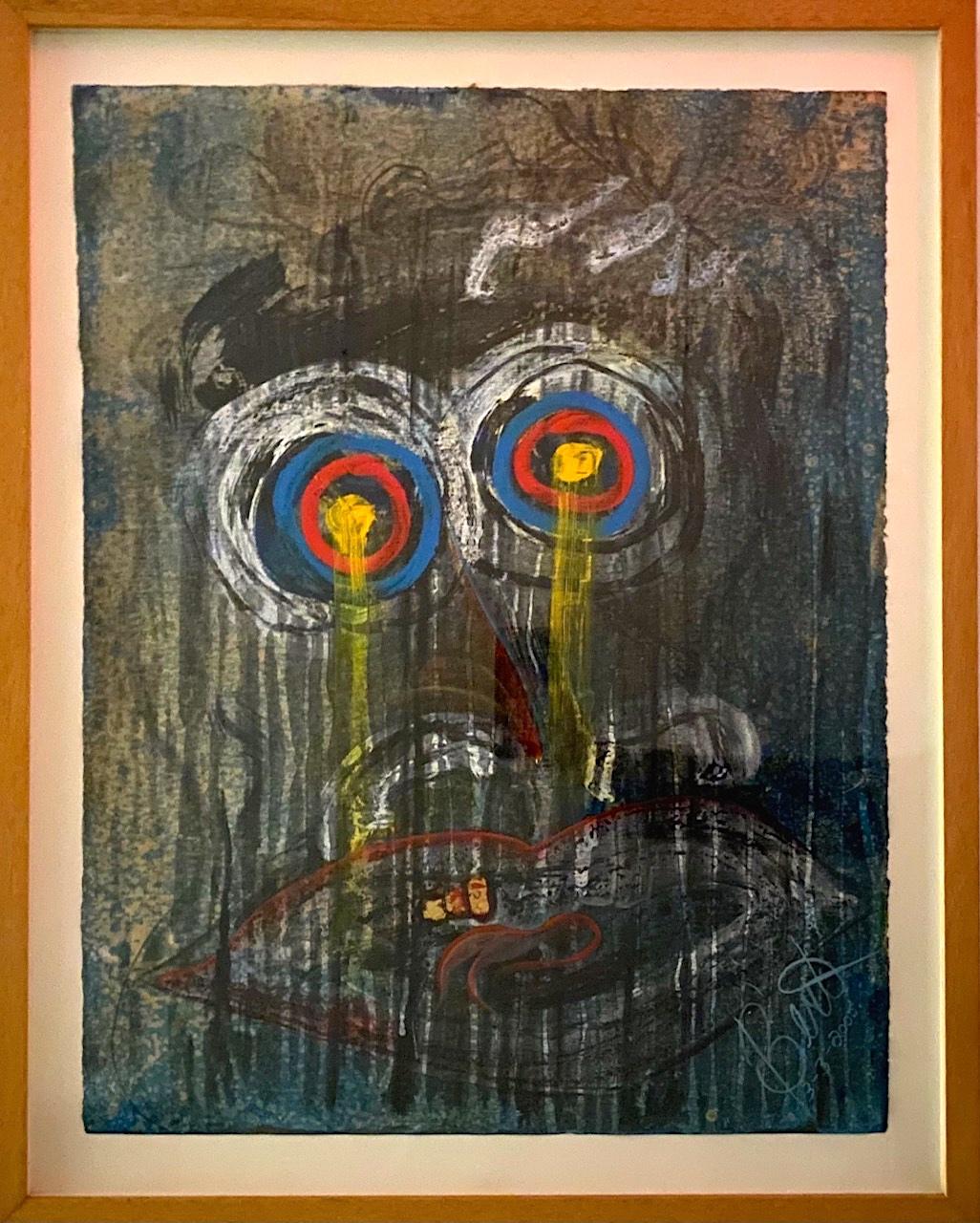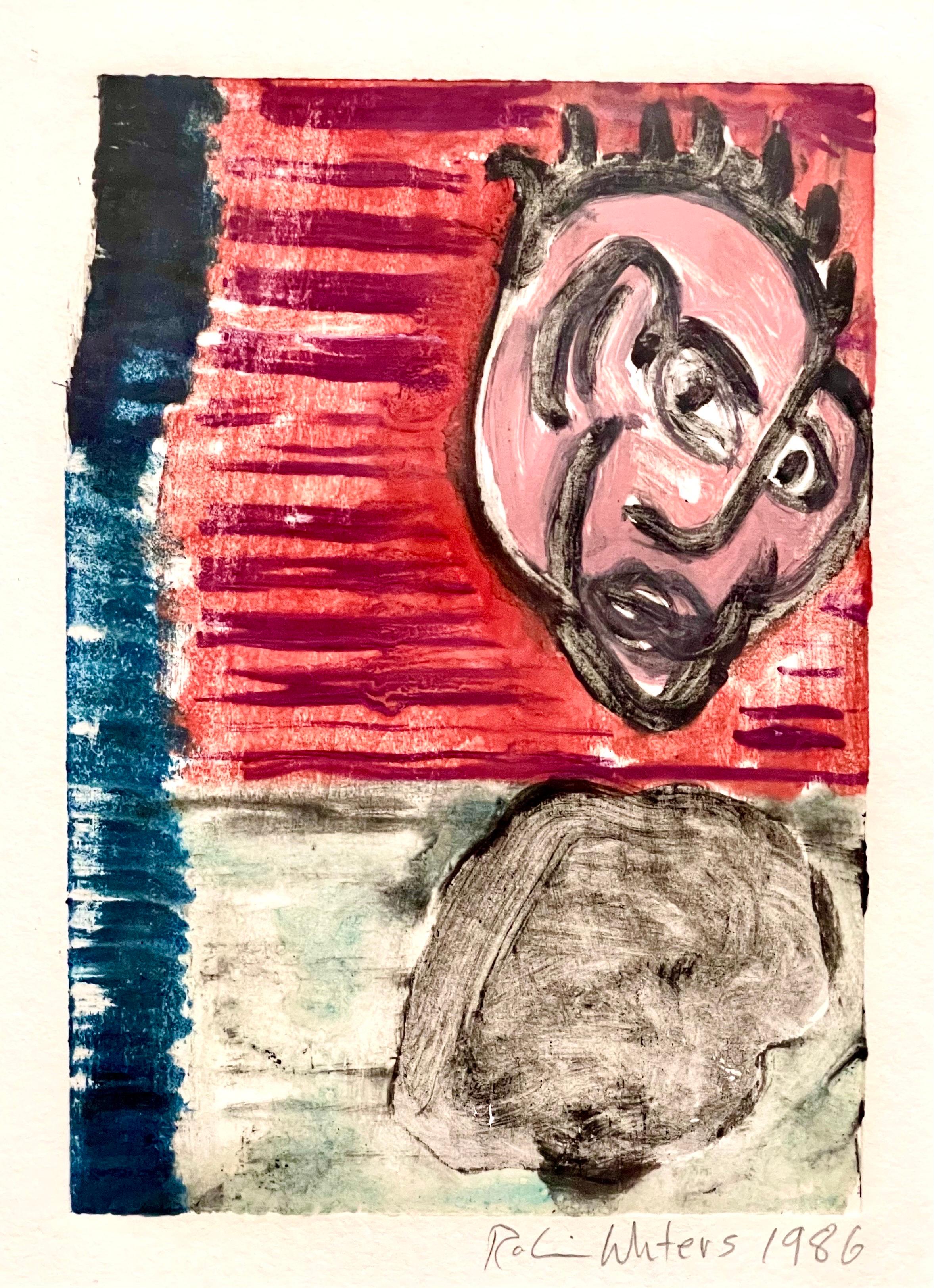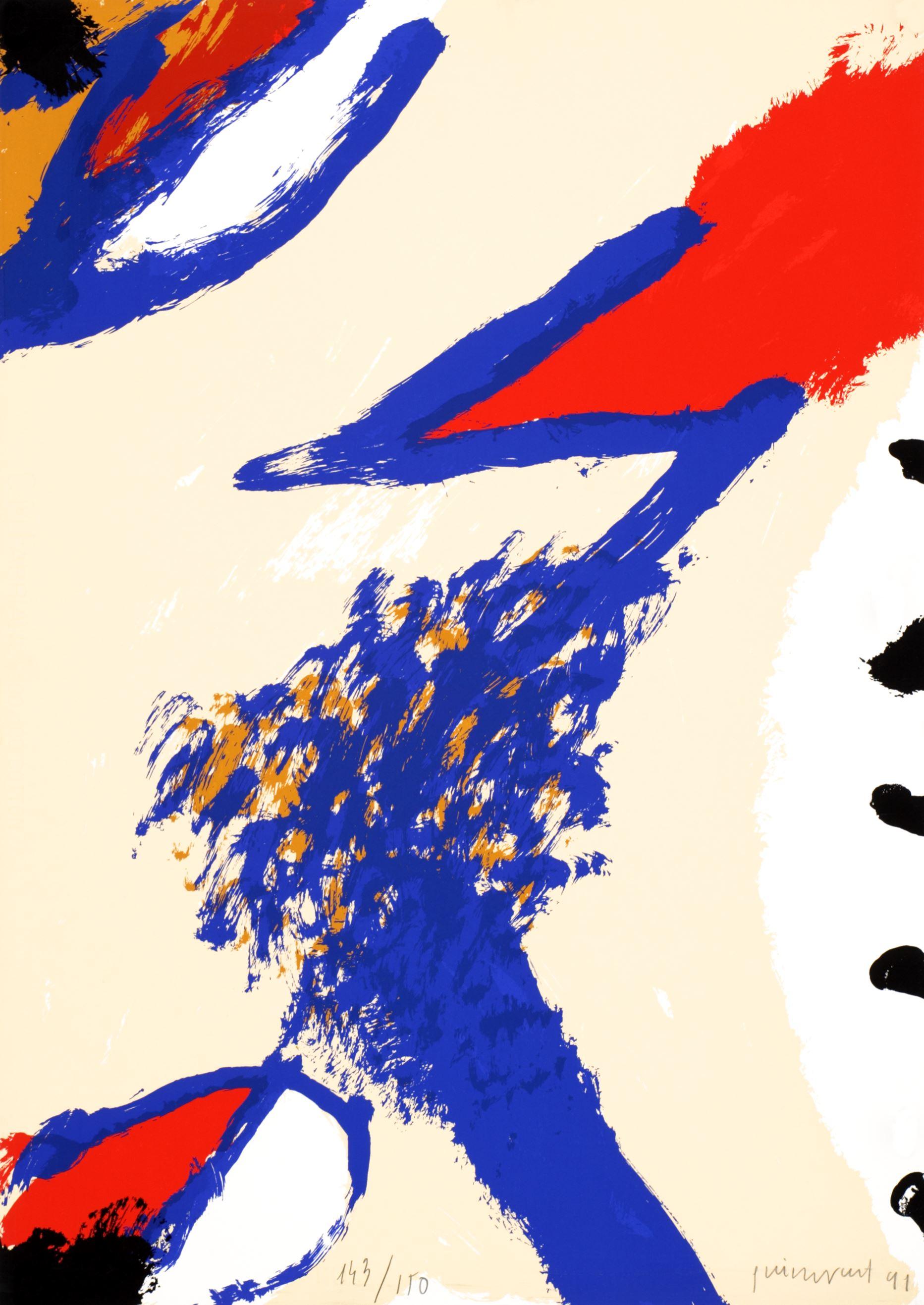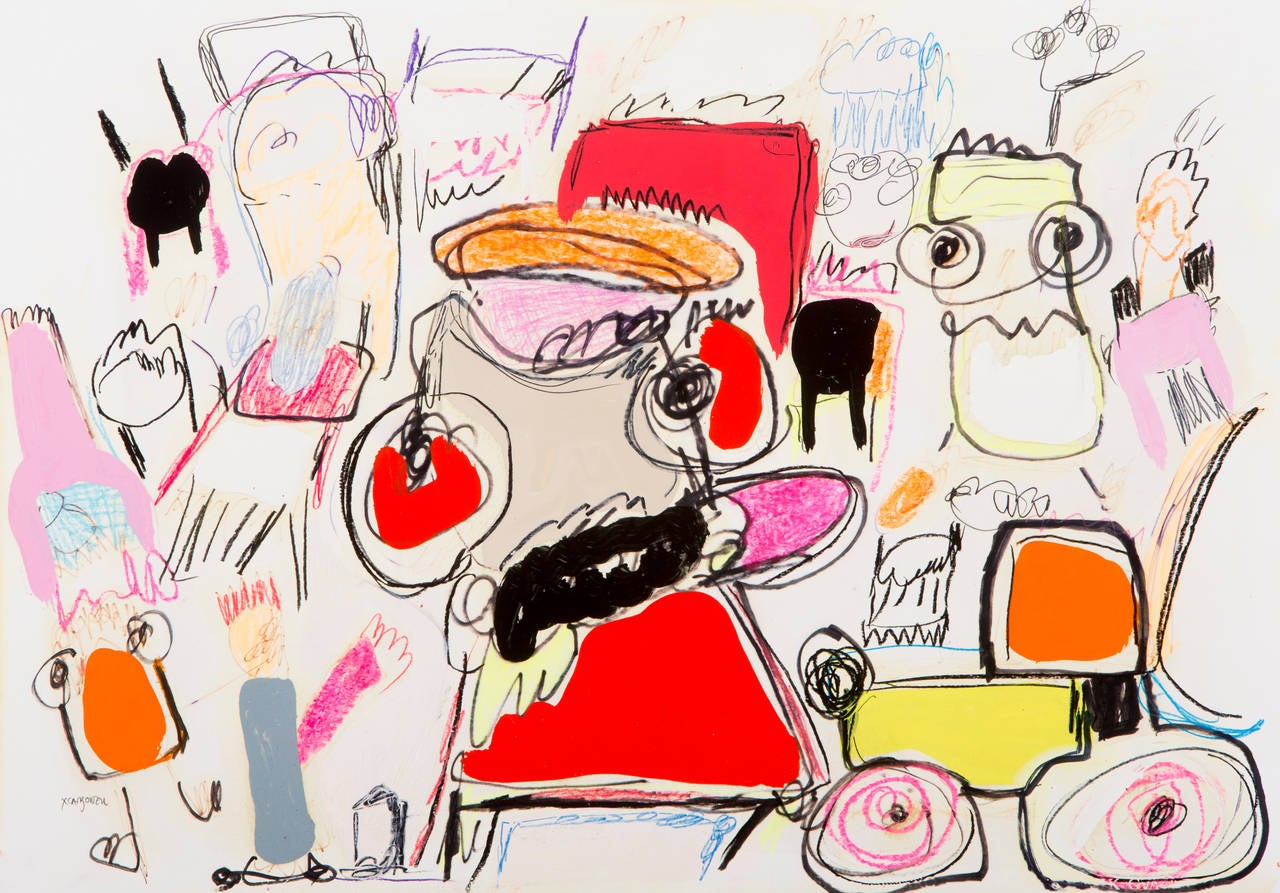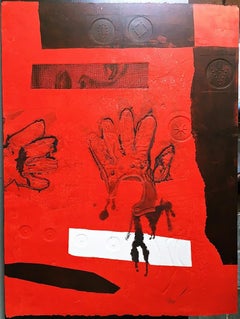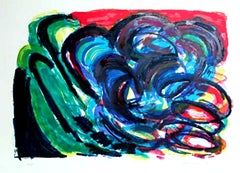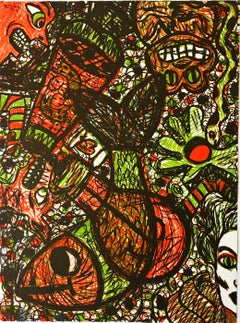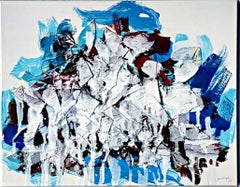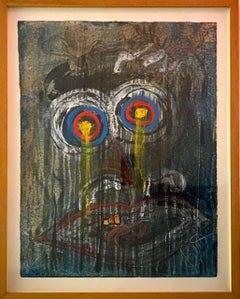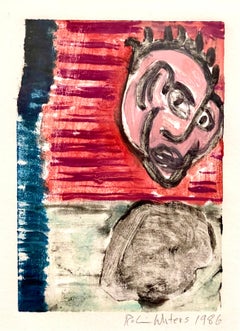Items Similar to Untitled Figure signed numbered mixed media print from scarce European portfolio
Want more images or videos?
Request additional images or videos from the seller
1 of 7
George McNeilUntitled Figure signed numbered mixed media print from scarce European portfolio1986
1986
$1,000
£776.19
€884.34
CA$1,429.11
A$1,556.41
CHF 820.64
MX$18,930.40
NOK 10,319.50
SEK 9,678.85
DKK 6,603.63
About the Item
George McNeil
Untitled Figure, 1986
Lithograph on paper. Publisher's and Printer's Blind
Stamps
Hand-signed, numbered 78/84 and dated by the artist on the front with publisher's and printer's blindstamps.
21 3/4 × 28 inches
Provenance:
Original Atelier International Portfolio #78
Unframed
This lithograph is hand signed, numbered and dated. Unframed and in fine condition as it is from the original Atelier International portfolio.
GEORGE MCNEIL (1908-1995) had a career that spanned the entire postwar American art era. McNeil attended Pratt Institute and the Art Students’ League, where he studied with Jan Matulka. From 1932-36, he studied with Hans Hofmann, becoming Hofmann's studio classroom monitor. In 1936 he worked for the Works Progress Administration Federal Art Project and became one of the founding members of the American Abstract Artists group. McNeil was one of the few abstract artists whose work was selected for the New York World's Fair in 1939. During World War II, he served in the US Navy. In the late 1940s McNeil taught at the University of Wyoming and then taught art and art history at Pratt Institute until 1980, influencing generations of young artists. A pioneer Abstract Expressionist of the New York School, McNeil had over forty solo exhibitions during his lifetime. Between the ’40s and until the mid ’60s his art was decidedly abstract but it was always joined to metaphor. From the ’70s onward, McNeil explored ways to expand beyond the cannons of Abstract Expressionism. In this period his work became more figurative, drawing inspiration from the dynamic life of the city, its dancers, discos and sports. Throughout his career as a painter McNeil commanded a mastery technique, capable of creating paintings of rich texture depth and color. In 1989, McNeil was elected to the American Academy of Arts and Letters. His work is represented in numerous museum collections around the country, including The Museum of Modern Art, New York, NY; The Metropolitan Museum of Art, New York, NY; Whitney Museum of America Art, New York, NY; San Francisco Museum of Art, San Francisco, CA; Los Angeles Museum of Contemporary Art, Los Angeles, CA; and Walker Art Center, Minneapolis, MN.
More about George McNeil
George McNeil [was] one of the most energetic of the American Expressionists. Born in Brooklyn, he remained there throughout his life. He studied in New York at Pratt Institute, the Arts Students League, with Hans Hofmann from 1933 to 1936, and at Columbia University. It was Hofmann who gave McNeil what he felt he needed as an artist, 'a strong spatial experience… and the ability to translate that into a two-dimensional equivalent.'
While McNeil’s early work owes much to the painterly abstraction of Hofmann, figurative traces are visible in it. By the early 1960s, the human figure was fully integrated into his paintings, this was done without, however, allowing the work to become illustrative. Since the 1980s, McNeil has been attracted to subjects within a specific environment, such as discotheques and disco dancing. Although the artist claims that he has never visited such places, the works produced with this theme reveal a mixture of dread and humor that is very much a part of the real subject.
Deliverance Disco is a bold, refreshing painting filled with raucous colors and forms that are about to explode out of the picture plane. Push and pull, a term used by Hofmann to explain the ability of color combinations to recede and move forward within a picture is clearly visible between the back and blue background and the two figures that fill most of the composition. The larger of the two figures is formed by brushstrokes and drips with patches of green, red, tan, orange, and gray. The dark background, with its minuscule white spots, has an infinite skylike quality that is further enhanced by tiny floating figures. Deliverance Disco, done in an exuberant painterly manner, is a joyous and satirical statement about the human condition.
Text Written by Alejandro Anreus (Emeritus) (Former Associate Curator at MAM)
-Courtesy of the Montclair Art Museum
- Creator:George McNeil (1908 - 1995)
- Creation Year:1986
- Dimensions:Height: 21.75 in (55.25 cm)Width: 14 in (35.56 cm)
- Medium:
- Movement & Style:
- Period:
- Condition:
- Gallery Location:New York, NY
- Reference Number:1stDibs: LU1745212519952
About the Seller
5.0
Platinum Seller
Premium sellers with a 4.7+ rating and 24-hour response times
Established in 2007
1stDibs seller since 2022
458 sales on 1stDibs
Typical response time: 2 hours
- ShippingRetrieving quote...Shipping from: New York, NY
- Return Policy
Authenticity Guarantee
In the unlikely event there’s an issue with an item’s authenticity, contact us within 1 year for a full refund. DetailsMoney-Back Guarantee
If your item is not as described, is damaged in transit, or does not arrive, contact us within 7 days for a full refund. Details24-Hour Cancellation
You have a 24-hour grace period in which to reconsider your purchase, with no questions asked.Vetted Professional Sellers
Our world-class sellers must adhere to strict standards for service and quality, maintaining the integrity of our listings.Price-Match Guarantee
If you find that a seller listed the same item for a lower price elsewhere, we’ll match it.Trusted Global Delivery
Our best-in-class carrier network provides specialized shipping options worldwide, including custom delivery.More From This Seller
View AllAbstract mixed media lithograph and relief by Spanish artist, Picasso friend S/N
By Antoni Clavé
Located in New York, NY
Antoni Clavé
Untitled, from the Album International 2 Portfolio, 1977
Mixed media: Lithograph in relief
29 1/4 × 19 3/4 inches
Edition 1/50
Signed and number on front
Unframed
This ...
Category
1970s Abstract Abstract Prints
Materials
Mixed Media, Lithograph
Description Without Place, abstract expressionist lithograph + silkscreen signed
By Claire Seidl
Located in New York, NY
Claire Seidl
Description Without Place (Hand Signed), 1986
Lithograph and silkscreen.
Hand signed, dated and numbered 17/65 by the artist.
28 × 38 1/2 inches
Unframed
Gorgeous Abstr...
Category
1980s Abstract Abstract Prints
Materials
Screen, Lithograph
Untitled, expressionistic woodcut print, from the Art Against AIDS Portfolio
By James Bettison
Located in New York, NY
James Bettison
Untitled, from the Art Against AIDS Portfolio, 1988
Woodcut on paper with deckled edges. Hand signed. Numbered 38/50. Dated. Printer's and Publisher's Blind Stamp.
20...
Category
1980s Contemporary Abstract Prints
Materials
Woodcut, Pencil
Collage Canvas Painting III (signed and inscribed to fellow artist & curator)
By Robert Goodnough, 1917-2010
Located in New York, NY
Robert Goodnough
Collage Canvas Painting III, 1983
Painted canvas collage on cardboard (signed twice and inscribed to artist and curator Matthew Rose)
S...
Category
1980s Abstract Expressionist Abstract Paintings
Materials
Canvas, Mixed Media, Oil
Untitled Abstract Expressionist painting on paper mid century modern art
By Rolph Scarlett
Located in New York, NY
Rolph Scarlett
Untitled Abstract Expressionist Painting, ca. 1960
Gouache, Ink, Watercolor on Paper . Hand signed, with original Jonas Aarons Gallery label
23 × 18 3/4 inches
Signed ...
Category
Mid-20th Century Abstract Expressionist Abstract Drawings and Watercolors
Materials
Watercolor, Gouache
Untitled, from the Long Point Gallery Portfolio
Located in New York, NY
Nora Speyer
Untitled, from the Long Point Gallery Portfolio, 1988
Lithograph on paper with deckled edges
Hand signed, numbered 22/30 and dated on lower front
22 × 15 inches
Unframed
Hand signed, numbered 22/30 and dated on lower front
Publisher: Long Point Gallery, Inc., Provincetown, Massachusetts; Printer: Bruce Porter from Trestle Editions Limited, New York
Rarely to market, this stunning 1988 woodcut was created by Nora Speyer as part of a portfolio produced for sale by Long Point Gallery, an artist's cooperative in Provincetown, Massachusetts.
Superb provenance as it is was acquired from the original Long Point Portfolio. This will be the first time the work will be removed from the portfolio.
It is hand signed and numbered from a very small edition of only 30; it is in fine condition, unframed and never framed, and housed in the original portfolio box, with the original colophon page, which also included works by 11 other artists.
For reference and provenance we have included an image of the colophon page from the complete portfolio.
About Nora Speyer:
The most exciting place to me is where I can communicate with the greatest number of artists. I can't live without some artists around. I'm not saying artists are likable. They can be very objectionable, but they are still my world.
Nora Speyer
Born in Pittsburgh, Speyer enrolled at Temple University's Tyler School of Art when she was sixteen. It was there she became roommates with Lillian Lent...
Category
1980s Abstract Abstract Prints
Materials
Pencil, Lithograph
You May Also Like
Homage to Robert Jones, Abstract Geometric Lithograph by Jay Milder
By Jay Milder
Located in Long Island City, NY
Artist: Jay Milder, American (1934 - )
Title: Homage to Robert Jones
Medium: Lithograph, signed and numbered in pencil
Edition: 275
Size: 27.5 x 39.5 in. (69.85 x 100.33 cm)
Category
1980s Abstract Expressionist Abstract Prints
Materials
Lithograph
"Untitled, " Acrylic on Paper - Figurative drawing
Located in Houston, TX
Faces are a recurring motif throughout Long’s extensive body of work - especially regarding eyes and mouths. This work features a misma of matter that coagulates into an image recogn...
Category
Early 2000s Contemporary Figurative Drawings and Watercolors
Materials
Paper, Acrylic
Conceptual Pop Art Color Oil Monotype Painting Abstract Figure Robin Winters
By Robin Winters
Located in Surfside, FL
Robin Winters (American, born 1950),
Untitled (Red Face) from "Cherry Block Series" 1986, monotype, pencil signed and dated lower right, plate: 6"h x 8.5"w, overall (with frame): 22.25"h x 18.25"w. Provenance: Property from a Private Collection, San Francisco.
Winters was invited to make monotypes at Experimental Workshop in San Francisco, (they printed Richard Bosman, Sam Francis, Claire Falkenstein, Deborah Oropallo and Kenneth Noland and many more greats). Winters chose to paint on wood blocks rather than the more usual metal plates in order to capture the organic quality of the natural material. He exploited a salient characteristic of the monoprint in Ghost Story by adding new painted elements onto the increasingly faint ghost images that result from successive impressions from a single block. In so doing he achieved the effect of transparent layers of color and shadow imagery. Winters's brightly-colored monotypes portray an array of figures and landscapes (and an occasional still-life) that, although can be seen in the context of a general trend away from abstraction that has marked the 1980s, defy strict stylistic categorization. They are neither realistic nor abstract, psychological self-examinations nor narrative fictions, but they contain elements of all of these approaches. Like Jonathan Borofsky, Winters derives much of his subject matter from dreams, believing that through his private fears and obsessions he can touch similar emotions in others. Although at first glance Winters's images look as if they could have been made by a child, closer attention reveals sly art historical references to Jackson Pollock and Pattern Painting (the drip and splatter backgrounds), Mark Rothko (the three-part horizontal compositions) and Minimalism (the gridded Cherry Block Series: Bread Beat).
Robin Winters (born 1950 in Benicia, California) is an American conceptual, multi-disciplinary, artist and teacher based in New York. Winters is known for creating solo exhibitions containing an interactive durational performance component to his installations, sometimes lasting up to two months. Winters first emerged in the burgeoning Soho NYC art scene of the 1970s. An early practitioner of the Relational Aesthetics (social interaction as an art medium) Winters also created in works through sculpture, installation, performance, painting, drawing and prints. His art maintains a whimsical spirit, and he often returns to ongoing themes involving faces, boats, cars, bottles, hats and jesters or fools. Winters has incorporated such devices as blind dates, double dates, dinners, fortune telling, and free consultation in his performances. Throughout his career he has engaged in a wide variety of media, such as performance art, film, video, writing prose and poetry, photography, installation art, printmaking, drawing, painting, ceramic sculpture, bronze sculpture, and glassblowing.
Winters was born in Benicia, California in 1950 to lawyer parents. As a child his hobby was collecting glass bottles found on the beach and under old buildings, which would later influence him as an artist. In 1968, Winters had his first durational performance, entitled Norman Thomas Travelling Museum. The artist drove a Volkswagen bus decorated in collage, many of the images relating to current events and politics. Inside was what the artist described as a “reliquary” containing many objects, including a bottle collection. Winters took the van to shopping centers and even as far as Mexico. That same year, Winters opted not to register for the military draft. Although he was deemed fit to serve, Winters refused. In 1975 the resulting legal proceedings finally came to a close after it was proven that the artist had been harassed by the local draft board. In his teens and early twenties, Winters became acquainted with several local artists who helped shape his aesthetic, most notably Manuel Neri and Robert Arneson. By the early 1970s, Winters was studying at the San Francisco Art Institute (SFAI) and had relocated to San Francisco. At this time Winters became friends with the Bay Area conceptual artists Terry Fox and Howard Fried, and participated in several of Fried's performance works. In 1972 Winters was accepted into the Whitney Independent Study Program in New York City. After coming to New York City, Winters helped support himself by working for various artists, among them the performance artist Joan...
Category
1980s Pop Art Figurative Paintings
Materials
Monoprint, Monotype
Untitled #1 Very large mixed media
By Terence La Noue
Located in San Francisco, CA
This artwork "Untitled #1" 1992, is a mixed media (Aquatint, screen print and collage) on heavy wove paper by noted American artist Terence David La Noue, b. 1941. It is hand signed,...
Category
Late 20th Century Abstract Abstract Prints
Materials
Mixed Media
Josep Guinovart Spanish Artist Original Hand Signed Mixed Media 1991
By Josep Guinovart Bertrán
Located in Miami, FL
Josep Guinovart (Spain, 1927-2007)
'Imatge i ocell', 1991
mixed media on paper
19.7 x 27.6 in. (50 x 70 cm.)
Edition of 150
ID: GUI1205-003-150_5
Hand-signed by author
______________...
Category
1990s Contemporary Prints and Multiples
Materials
Mixed Media, Screen
Xavi Carbonell, Untitled, Mixed media on paper, 2014
By Xavi Carbonell
Located in New York, NY
Spanish artist Xavi Carbonell born 1971, actively paints like a child as an adult, and leaves all of his pieces "untitled" so that each viewer can create their own story. The result...
Category
2010s Abstract Abstract Paintings
Materials
Mixed Media
More Ways To Browse
Chagall 1964
Chagall Paradise
Chateau Mouton Rothschild
Chiaroscuro Woodcut
Clare Romano
Dali Butterfly
Dali Paradise
David And Bathsheba
David Hockney Ipad
Don Quixote Lithograph
Durer Woodcut
Francisco Goya Y Lucientes
French Midcentury 1960s Mens Fashion
Gaetano Pompa
Gordon Craig
Guillermo Silva
Henri Matisse Dancer Artworks
Into 84 Keith Haring
